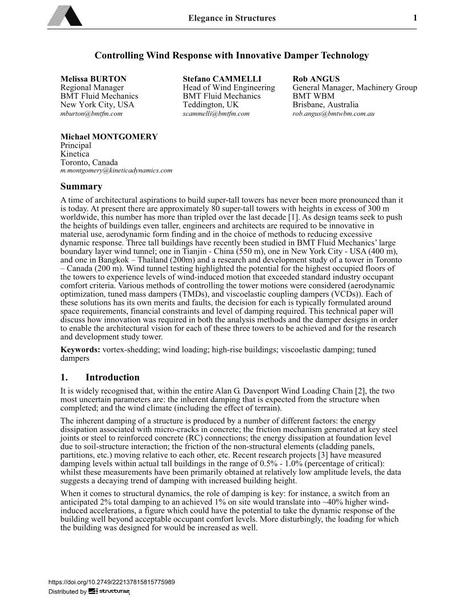Controlling Wind Response with Innovative Damper Technology

|
|
|||||||||||
Bibliographic Details
| Author(s): |
Melissa Burton
Stefano Cammelli Rob Angus Michael Montgomery |
||||
|---|---|---|---|---|---|
| Medium: | conference paper | ||||
| Language(s): | English | ||||
| Conference: | IABSE Conference: Elegance in structures, Nara, Japan, 13-15 May 2015 | ||||
| Published in: | IABSE Conference Nara 2015 | ||||
|
|||||
| Page(s): | 492-493 | ||||
| Total no. of pages: | 8 | ||||
| Year: | 2015 | ||||
| DOI: | 10.2749/222137815815775989 | ||||
| Abstract: |
A time of architectural aspirations to build super-tall towers has never been more pronounced than it is today. At present there are approximately 80 super-tall towers with heights in excess of 300 m worldwide, this number has more than tripled over the last decade [1]. As design teams seek to push the heights of buildings even taller, engineers and architects are required to be innovative in material use, aerodynamic form finding and in the choice of methods to reducing excessive dynamic response. Three tall buildings have recently been studied in BMT Fluid Mechanics' large boundary layer wind tunnel; one in Tianjin - China (550 m), one in New York City - USA (400 m), and one in Bangkok - Thailand (200m) and a research and development study of a tower in Toronto - Canada (200 m). Wind tunnel testing highlighted the potential for the highest occupied floors of the towers to experience levels of wind-induced motion that exceeded standard industry occupant comfort criteria. Various methods of controlling the tower motions were considered (aerodynamic optimization, tuned mass dampers (TMDs), and viscoelastic coupling dampers (VCDs)). Each of these solutions has its own merits and faults, the decision for each is typically formulated around space requirements, financial constraints and level of damping required. This technical paper will discuss how innovation was required in both the analysis methods and the damper designs in order to enable the architectural vision for each of these three towers to be achieved and for the research and development study tower. |
||||
| Keywords: |
high-rise buildings wind loading vortex shedding viscoelastic damping tuned dampers
|
||||
